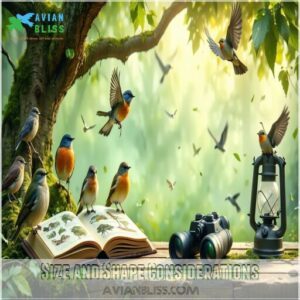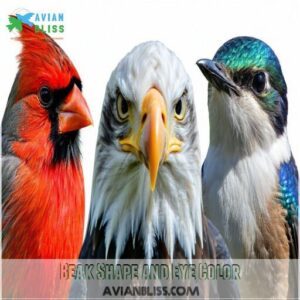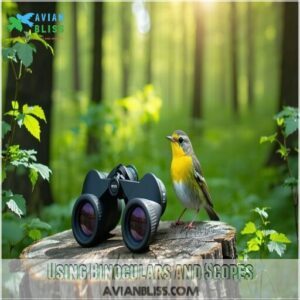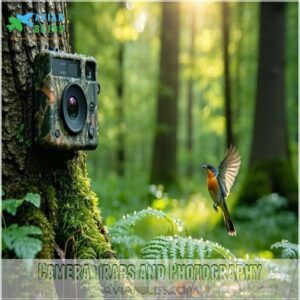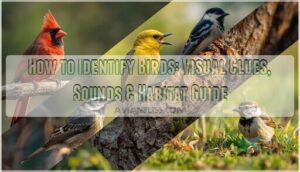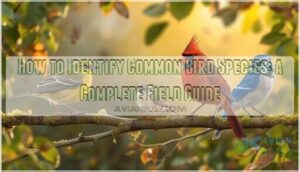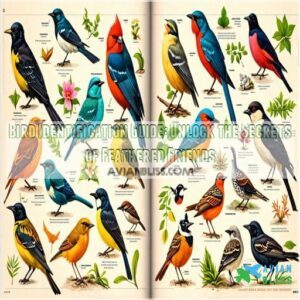This site is supported by our readers. We may earn a commission, at no cost to you, if you purchase through links.
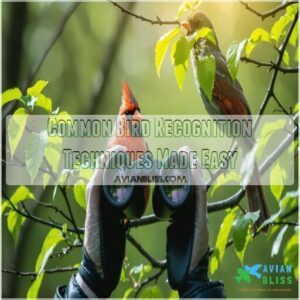
Start by observing physical characteristics like size, feather texture, and beak shape. Don’t forget to note plumage patterns, eye color, and leg length.
With practice, you’ll become proficient in identifying birds using these features. Using field guides, smartphone apps, and binoculars can also aid in recognition.
As you hone your skills, you’ll discover that each bird species has unique traits – and that’s just the beginning of uncovering the fascinating world of bird identification, where every detail counts and mastering these techniques will lead to a deeper understanding of the subject, allowing for more efficient identification.
Table Of Contents
- Key Takeaways
- Bird Physical Features
- Choosing Right Tools
- Visual Observation Techniques
- Auditory Recognition Methods
- Behavioral Identification Clues
- Frequently Asked Questions (FAQs)
- What are the different birdwatching techniques?
- What is the best online guide for identifying birds?
- How can i Improve my birding experience?
- What is a bird identification guide?
- How to observe birds?
- How do you identify birds in a bird identification toolkit?
- What are the five ways to identify birds?
- What is the most common method used to capture birds?
- What are the 4 keys to bird ID?
- Is there a device that identifies birds?
- Conclusion
Key Takeaways
- You’ll master bird identification by observing physical characteristics like size, shape, and plumage patterns, and using tools like field guides, apps, and binoculars to enhance your skills.
- You’ll learn to identify birds by their unique songs and calls, and by observing their behavioral traits, such as feeding habits and social interactions, to gain a deeper understanding of their unique characteristics.
- You’ll use a combination of visual observation, auditory recognition, and field guide methods to identify birds, and you’ll find that mastering these techniques becomes second nature with practice.
- You’ll discover that the right tools, such as the Merlin Bird ID app and eBird online guide, can help you skyrocket your birding experience, and that honing your skills will allow you to efficiently identify birds and appreciate their unique characteristics.
Bird Physical Features
You’ll start by examining a bird’s physical features, including its size, shape, and plumage patterns.
By observing these characteristics, you’ll be able to identify key traits that distinguish one species from another, making it easier to recognize birds in the wild.
Size and Shape Considerations
When identifying birds, consider overall size, body shape, wingspan, tail length, and head proportions.
Note the bird’s size and shape to narrow down possibilities.
For a detailed guide, explore various bird species by size.
Size and shape are key factors in bird identification, helping you distinguish between similar species and make a more accurate identification, which relies on understanding the bird’s overall size.
Plumage Patterns and Colors
You’ll notice bird plumage varies with seasonal changes, molting patterns, and color variations, making field marks key to identification.
As camouflage and distinctive patterns aid recognition of bird species, with color and coloration playing a significant role in understanding plumage patterns.
Beak Shape and Eye Color
You’ll examine beak shape and eye color to refine bird identification.
Beak types, like conical or hooked, and eye colors, such as brown or yellow, are key physical characteristics.
These distinctive features, along with facial markings and head patterns, aid in bird recognition techniques, building on plumage patterns and utilizing key physical characteristics.
Leg Length and Feather Texture
When observing birds, consider leg length and feather texture, as these physical characteristics, along with plumage details and bird posture, can aid in bird identification techniques.
Revealing unique features like leg color, and overall bird shapes, to master recognizing various bird features and species, is crucial for effective bird identification, which relies on bird identification techniques.
Choosing Right Tools
You’ll need to choose the right tools to improve your bird recognition skills, and this includes selecting the best field guides, smartphone apps, and binoculars for your needs.
By picking the right equipment, you’ll be able to observe and identify birds more effectively, making your birdwatching experiences more enjoyable and rewarding.
Field Guides
You’ll find field guides indispensable for bird recognition. They offer Field Guide Tips, Birding Maps, and Species Lists, helping you master identification with guide books and Identification Keys, making your bird field guide a valuable resource, alongside other bird identification guides and your trusty bird guide.
Understanding bird watching equipment is essential for effective bird recognition and observation, which is a key part of the overall birding experience.
Smartphone Apps
You’ll love using smartphone apps for bird ID.
Top apps include:
- Cornell’s Merlin
- ChirpOMatic
- Smart Bird ID
- Song Sleuth
- Bird Genie, offering photo analysis and audio assist, making bird identification a breeze with digital guides.
These apps utilize bioacoustics technology to identify species accurately, using digital guides.
Binoculars and Spotting Scopes
Investing in good binoculars and spotting scopes enhances bird watching.
Look for optical quality, lens coatings, and eyepiece designs.
Consider scope mounts and magnification power for clearer views, aiding in bird identification and making your birding adventures more enjoyable with the right tools and bird field guide.
Understanding bird identification techniques is important for a successful birding experience.
Visual Observation Techniques
You’ll use visual observation techniques to identify birds by sight, focusing on physical characteristics like beak shape and plumage color.
By using binoculars, scopes, and cameras, you can get a closer look at birds in their natural habitat and make more accurate identifications.
Using Binoculars and Scopes
You’ll enjoy bird watching with good binoculars and scopes. Here are key features:
- Optical Clarity
- Lens Quality
- Scope Mounts
- Eyepiece Design
- Focus Techniques, for sharp views and easy bird identification.
Camera Traps and Photography
You’ll master bird photography by adjusting camera settings and using image software for photo analysis, employing trap placement strategies and wildlife photography techniques for stunning shots.
Aiding in photographic identification and bird watching tips, including bird identification by color, with camera traps, is crucial for effective bird photography.
Effective use of camera traps involves understanding advanced camera trap systems to capture high-quality images, which is key to bird identification and stunning shots.
Scouting and Familiarization
You’re scouting areas, familiarizing yourself with local species and habitats before a trip, which aids in bird identification and recognition, making your bird watching experience more efficient with pre-trip planning and site familiarization using a bird field guide for visual identification.
Understanding bird behavior and socialization is essential for effective birdwatching, as it helps in recognizing patterns and socialization habits of birds.
Auditory Recognition Methods
You’ll learn to identify birds by their unique songs and calls, which is an essential skill for any bird enthusiast.
By recognizing these auditory cues, you can quickly pinpoint species and enhance your overall birding experience, even when visual sightings are limited, which makes recognizing these cues a vital part of the process.
Bird Calls and Songs
You learn bird calls and songs to identify species.
- Bird Songs
- Call Patterns
- Vocal Learning
- Song Structure
- Auditory Cues aid identification by sound, using vocalizations like bird calls and songs.
Audio Recording and Analysis
You’ll analyze bird songs and calls using Sound Wave Analysis and Audio Filters to identify patterns.
Applying Noise Reduction and Spectrogram Reading for accurate bird identification by sound, making audio recording a valuable tool for recognizing bird calls and songs in bird identification, utilizing Audio Filters for clearer results.
Behavioral Identification Clues
You’ll learn to identify birds by observing their behavioral traits, such as feeding habits and social interactions.
By recognizing these clues, you can accurately identify bird species and gain a deeper understanding of their unique characteristics, which is crucial for accurately identify.
Feeding Habits and Social Interactions
You observe birds’ feeding habits and social interactions, noting flocking, foraging strategies, and courtship displays.
To identify species, understanding their unique behaviors, such as territorial disputes and predator mobbing, is crucial.
These behaviors reveal their social behaviors and feeding behavior, aiding in bird behavior identification, particularly through observing predator mobbing.
Flight Patterns and Nesting Preferences
You’ll notice distinct flight patterns and nesting preferences in birds.
- Flight Styles
- Nesting Sites
- Migration Routes
- Flocking Behavior
Aerial Displays aid bird identification, revealing nesting areas and bird behavior, including unique flight patterns and migration patterns.
Habitat and Migration Patterns
You’ll find birds in specific habitats, following migration routes and seasonal patterns.
Understanding bird habitats, migration patterns, and geographic distribution helps identify species, as different birds prefer certain habitat types and exhibit unique bird movements during seasonal variations, making it easier to recognize them in their natural environments.
The study of bird migration patterns is essential for understanding these movements and behaviors, and it helps in recognizing unique bird movements and seasonal variations.
Frequently Asked Questions (FAQs)
What are the different birdwatching techniques?
You’ll discover various birdwatching techniques, including visual observation, auditory recognition, and field guide methods, to enhance your bird identification skills and connect with nature.
What is the best online guide for identifying birds?
You’ll find the Merlin Bird ID app and eBird online guide are excellent resources for identifying birds.
offering detailed descriptions, images, and audio recordings.
to help you master bird recognition skills easily.
How can i Improve my birding experience?
You’ll skyrocket your birding experience by leveraging field guides, apps, and binoculars, while honing your visual and auditory recognition skills to identify species with ease and precision always.
What is a bird identification guide?
You’ll use a bird identification guide, a detailed resource that helps you recognize species by their physical characteristics, behaviors, and habitats, making your birding adventures more enjoyable and informative.
How to observe birds?
You’ll observe birds by focusing on size, shape, color, and behavior, using tools like binoculars, field guides, and apps to enhance your identification experience and connect with nature.
How do you identify birds in a bird identification toolkit?
You’ll identify birds using tools like field guides, apps, and binoculars, considering size, shape, color, and behavior to pinpoint species with precision and accuracy, every time.
What are the five ways to identify birds?
You’ll master bird identification through size, shape, color, behavior, and habitat, plus auditory recognition, field guides, and technology-assisted tools, making it easier to recognize species.
What is the most common method used to capture birds?
Flashback to ancient times, you’ll likely discover that mist nets are the most common method used to capture birds, allowing for safe handling and research, don’t you think?
What are the 4 keys to bird ID?
You’ll use size, shape, color pattern, and behavior as the 4 keys to master bird identification, helping you quickly group and recognize species with ease and accuracy every time.
Is there a device that identifies birds?
Like a detective, you’ll love that yes, there are devices, such as birding apps, that help you identify birds, making it a breeze to spot species.
Conclusion
Notably, you’ll find mastering common bird recognition techniques becomes second nature with practice.
As you refine your skills, you’ll efficiently identify birds using physical features and tools, making common bird recognition techniques a fun, engaging hobby.
Allowing you to appreciate the unique characteristics of each species, and deepen your understanding of common bird recognition techniques.
- https://wildbirdlady.com/what-are-some-common-birdwatching-techniques/
- https://feederwatch.org/learn/identifying-birds/
- https://www.allaboutbirds.org/news/
- https://pmc.ncbi.nlm.nih.gov/articles/PMC10890763/
- https://www.researchgate.net/publication/333298551_Bird_Image_Retrieval_and_Recognition_Using_a_Deep_Learning_Platform

